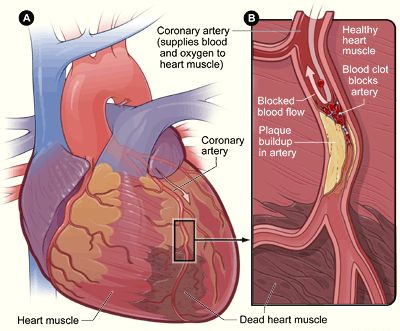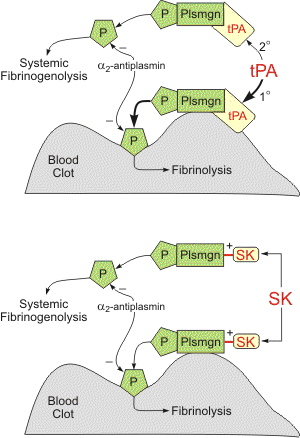

Thrombolytic Drugs
Thrombolytic therapy is a treatment for breaking up dangerous clots. Thrombolytic, or clot-busting, drugs are administered intravenously or through catheter tubes. They are typically used to dissolve clots in the arteries of patients who had just suffered a heart attack or an ischemic stroke. (Note that they are not given to patients with hemorrhagic strokes as those occur due to bleeding in the brain.) Thrombolysis is also used to treat acute pulmonary embolisms, which are caused by blockages in the lung arteries.
Three types of thrombolytics are tissue plasminogen activator (tPA), streptokinase (SK), and urokinase (UK).
Illustration of blood clot (Multimedia Citation 39)
Types of Thrombolytics
The most commonly used thrombolytic drugs are tissue plasminogen activators due to their selectivity. To dissolve clots, tPA binds to fibrin on the clot and activates plasminogen, the inactive precuror to plasmin. Plasmin is a protease (an enzyme that catabolizes proteins). It dissociates with the plasminogen and begins to break about the fibrin molecules which hold the clot together. They also break down other proteins such as fibrinogen. However, the breakdown of fibrinogin occurs less in tPA drugs than in UK and SK drugs because tPA tends to select clot-bound plasminogin over circulating plasminogen. However, when it does activate circulating plasminogen, the plasmin released can break down circulating fibrinogen and lead to "an unwanted systemic fibrinolytic state" and bleeding (Citation 33). α2-antiplasmin normally prevent this by inactivating plasmin, but plasmin formation caused by tPA and SK overwhelm them and prevent them from functioning as usual.
Streptokinase, unlike tPA, is not a protease . It is an enzyme found in streptococci which joins together with plasminogen in a complex and releases plasmin. It is not selective and binds to both circulating and clot-bound fibrinogen. Although it can dissolve clots effectively, it also causes severe fibrinogenolysis as side effect. As a result, tPA are usually favored as a thrombolytic agent over SK.

Diagram of the mechanisms for SK and tPA.
(Multimedia Citation 38)